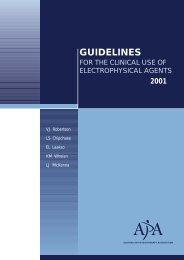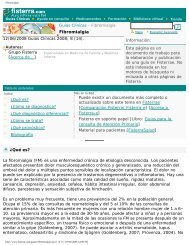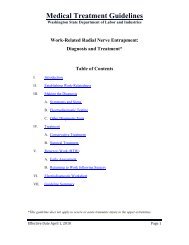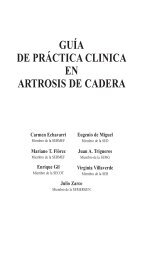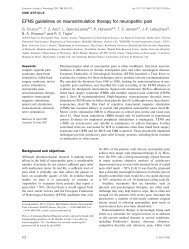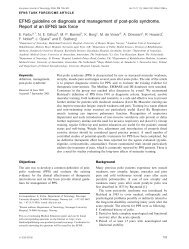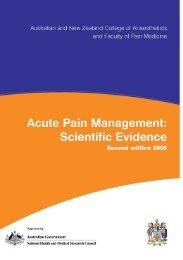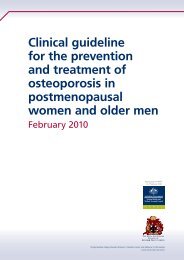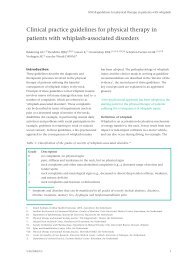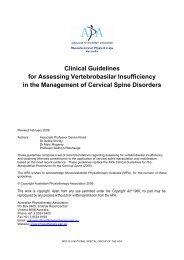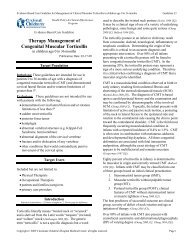Practice Parameter and Literature Review of the Usefulness of ...
Practice Parameter and Literature Review of the Usefulness of ...
Practice Parameter and Literature Review of the Usefulness of ...
Create successful ePaper yourself
Turn your PDF publications into a flip-book with our unique Google optimized e-Paper software.
<strong>Practice</strong> <strong>Parameter</strong>: Carpal Tunnel Syndrome159. Marinacci AA. Comparative value <strong>of</strong> measurement <strong>of</strong> conductionvelocity <strong>and</strong> electromyography in <strong>the</strong> diagnosis <strong>of</strong> carpal tunnelsyndrome. Arch Phys Med Rehabil 1964;45:548-554. Criteria Met(4/6: 1,2,3,5) Source: Nathan, 1988. Abstract: With stimulation at <strong>the</strong>wrist, elbow <strong>and</strong> axilla, <strong>and</strong> recording over <strong>the</strong> APB, motor NCVs <strong>and</strong>DMLs were determined in 204 patients having CTS <strong>and</strong> 64 controlsubjects. Needle EMG was also performed in this group; 70% <strong>of</strong> CTScases had abnormal wrist DML <strong>and</strong> <strong>the</strong> needle EMG was abnormal in96% <strong>of</strong> <strong>the</strong> cases (fibrillations, polyphasic units, <strong>and</strong> large amplitudemotor units). Sensory latencies were also recorded in 23 CTS patients.160. Marsh DR. Use <strong>of</strong> a wheel es<strong>the</strong>siometer for testing sensibility in <strong>the</strong>h<strong>and</strong>. J H<strong>and</strong> Surg Br 1986;11:182-186. Criteria Met (3/6: 1,2,3)Source: Medline Search.161. Mavor H, Shiozawa R. Antidromic digital <strong>and</strong> palmar nerve actionpotentials. Electroencephalogr Clin Neurophysiol 1971;30:210-221.Criteria Met (4/6: 1,3,5,6) Source: Buchthal, 1974. Abstract: Withstimulation at <strong>the</strong> elbow <strong>and</strong> wrist <strong>and</strong> recording over <strong>the</strong> middlefinger, SNAPs <strong>and</strong> DSLs from <strong>the</strong> median nerve were recorded in 21normal subjects. With stimulation over <strong>the</strong> ulnar nerve at <strong>the</strong> elbow<strong>and</strong> wrist, antidromic SNAPs <strong>and</strong> DSLs were recorded in 13 normalsubjects. No CTS patients were studied.162. Mayer RF. Nerve conduction studies in man. Neurology 1962;12:733-744. Criteria Met (4/6: 1,3,5,6) Source: Kraft, 1983. Abstract: Thefollowing techniques were studied in 64 normal subjects <strong>and</strong> 31diabetics without peripheral neuropathy: (a) stimulation in axilla,above elbow <strong>and</strong> wrist with recording <strong>of</strong> <strong>the</strong> CMAP over <strong>the</strong> APB.Surface <strong>and</strong> concentric needle electrodes were used, (b) withstimulation in <strong>the</strong> axilla, above <strong>the</strong> elbow <strong>and</strong> wrist, SNAPs wererecorded from digital nerves using surface <strong>and</strong> needle electrodes, (c)ulnar, (d) peroneal, (e) tibial, <strong>and</strong> (f) H reflex. They found a slightdecrease in NCV in patients older than 50, <strong>and</strong> in patients withdiabetes mellitus without clinical signs <strong>of</strong> peripheral neuropathy. NoCTS patients were studied.163. *Mazur A. Role <strong>of</strong> <strong>the</strong>nar electromyography in <strong>the</strong> evaluation <strong>of</strong>carpal tunnel syndrome. Phys Med Rehabil Clin N Am 1998;9:755-764. <strong>Review</strong> article. Background Reference. Source: Medline Search.Abstract: The author suggests that needle EMG <strong>of</strong> <strong>the</strong> APB (1) is notnecessary to evaluate most cases <strong>of</strong> CTS <strong>and</strong> (2) be reserved foratypical situations or unusual presentations <strong>of</strong> CTS such as when (a)NCS cannot be performed or (b) when <strong>the</strong> median nerve pathology ispotentially aggressive causing significant axonal injury over a shorttime.164. McLellan DL, Swash M. Longitudinal sliding <strong>of</strong> <strong>the</strong> median nerveduring movements <strong>of</strong> <strong>the</strong> upper limb. J Neurol Neurosurg Psychiat.1976;39:566-570. Background Reference. Source: AAEM CTS TaskForce 2000 member. Normal subjects. An incidental finding duringrecording <strong>of</strong> median NAP with monopolar needle electrode in <strong>the</strong>median nerve in <strong>the</strong> upper arm was that <strong>the</strong> nerve slid longitudinallyseveral mm when <strong>the</strong> limb moved at a joint. Wrist extension <strong>and</strong>flexion resulted in opposite directions <strong>of</strong> sliding movement. Note: <strong>the</strong>needle in nerve may have impeded movement leading tounderestimates <strong>of</strong> magnitude <strong>of</strong> sliding.165. McNeil BJ, Keller E, Adelstein SJ. Primer on certain elements <strong>of</strong>medical decision making. NEJM 1975;293:211-215. BackgroundReference. Source: Gunnarsson 1997 paper.166. Melvin JL, Harris DH, Johnson EW. Sensory <strong>and</strong> motor conductionvelocities in <strong>the</strong> ulnar <strong>and</strong> median nerves. Arch Phys Med Rehabil1966;47:511-519. Criteria Met (4/6: 1,3,5,6) Source: Joynt, 1989.Abstract: The following techniques were studied: (a) orthodromicSNAPs were recorded from <strong>the</strong> median nerve at <strong>the</strong> wrist <strong>and</strong> elbow,(b) orthodromic SNAPs were recorded from <strong>the</strong> ulnar nerve afterstimulation <strong>of</strong> <strong>the</strong> ring <strong>and</strong> little fingers <strong>and</strong> recording over <strong>the</strong> wrist<strong>and</strong> elbow, (c) antidromic SNAPs were recorded from <strong>the</strong> median <strong>and</strong>ulnar nerve after reversing <strong>the</strong> electrodes for <strong>the</strong> orthodromic SNAPs,(d) median CMAPs recording over <strong>the</strong> opponens pollicus, <strong>and</strong> (e)ulnar CMAP over <strong>the</strong> abductor digiti quinti. The orthodromic NCVswere determined in 48 normal persons, motor conduction NCVs weredetermined in 47 normal people <strong>and</strong> antidromic SNAPs werecompleted in 36 normal people. No CTS patients were studied. Theyfound <strong>the</strong>re was no significant difference between orthodromic <strong>and</strong>antidromic sensory NCVs <strong>and</strong> that <strong>the</strong> fastest afferent sensory NCVswere faster than <strong>the</strong> fastest efferent motor fibers.167. Melvin JL, Schuchmann JA, Lanese RR. Diagnostic specificity <strong>of</strong>motor <strong>and</strong> sensory nerve conduction variables in <strong>the</strong> carpal tunnelsyndrome. Arch Phys Med Rehabil 1973;54:69-74. Criteria Met (5/6:1,2,3,5,6) Source: Redmond, 1988. Abstract: With stimulation at <strong>the</strong>wrist <strong>and</strong> recording CMAP over <strong>the</strong> APB <strong>and</strong> SNAP over <strong>the</strong> index<strong>and</strong> middle finger, latency, velocities, <strong>and</strong> amplitudes weredetermined from 24 normal volunteers <strong>and</strong> 19 patients with CTS.They found that <strong>the</strong> DSL followed by <strong>the</strong> DML were <strong>the</strong> best tests<strong>and</strong> that sensory duration, sensory amplitude, motor amplitude, <strong>and</strong>motor duration were not sensitive.168. Merchut MP, Kelly MA, Toleikis SC. Quantitative sensory thresholdsin carpal tunnel syndrome. Electromyogr Clin Neurophysiol1990;30:119-124. Criteria Met (5/6: 1,2,3,4,6) Source: MedlineSearch. Abstract: Twenty-eight h<strong>and</strong>s from 23 patients with CTS asdefined by 1 or more <strong>of</strong> <strong>the</strong>se abnormal NCSs; orthodromic DSLmedian-ulnar difference from ring finger-to-wrist, palm-to-wristmedian DSL, finger-to-wrist median DSL, or DML from <strong>the</strong> wrist-to-APB. Quantitative sensory threshold (QST) testing was done usingvibration thresholds <strong>and</strong> <strong>the</strong>rmal sensitivity thresholds comparing <strong>the</strong>index to little finger in 23 age matched control subjects. AbnormalQST was found in only 3 <strong>of</strong> <strong>the</strong> 28 symptomatic h<strong>and</strong>s (11%) <strong>and</strong> wasfound to be much less sensitive than NCSs.169. Merhar GL, Clark RA, Schneier HJ, Stern PJ. High-resolutioncomputed tomography <strong>of</strong> <strong>the</strong> wrist in patients with carpal tunnelsyndrome. Skeletal Radiol 1986;15:549-552. Criteria Met (3/6: 1,3,6)Source: Medline Search.170. Meyers S, Cros D, Sherry B, Vermeire P. Liquid crystal<strong>the</strong>rmography: quantitative studies <strong>of</strong> abnormalities in carpal tunnelsyndrome (comments in Neurology 1990;40:1146). Neurology1989;39:1465-1469. Criteria Met (2/6: 1,2) Source: Medline Search.171. Mills KR. Orthodromic sensory action potentials from palmarstimulation in <strong>the</strong> diagnosis <strong>of</strong> carpal tunnel syndrome. J NeurolNeurosurg Psychiatry 1985;48:250-255. Criteria Met (4/6: 1,3,5,6)Source: Golding, 1986. Abstract: While recording at <strong>the</strong> wrist over<strong>the</strong> median <strong>and</strong> ulnar nerves, SNAPs were elicited by stimulation over<strong>the</strong> index <strong>and</strong> little fingers <strong>and</strong> from stimulation in <strong>the</strong> palm (mixednerve); 72 h<strong>and</strong>s with CTS, 53 healthy h<strong>and</strong>s <strong>and</strong> 20 h<strong>and</strong>s <strong>of</strong> patientswith unrelated neurological conditions were evaluated. They foundthat <strong>the</strong> palm-to-wrist conduction velocity <strong>and</strong> <strong>the</strong> palm-to-wristmedian-ulnar comparison was more likely to be abnormal than <strong>the</strong>DSL or DML. They also found no significant difference between <strong>the</strong>normal control group <strong>and</strong> <strong>the</strong> 20 h<strong>and</strong>s with unrelated neurologicconditions.172. Molitor PJ. A diagnostic test for carpal tunnel syndrome usingultrasound. J H<strong>and</strong> Surg Br 1988;1340-1341. Criteria Met (3/6: 1,3,5)Source: Medline Search.173. Monga TN, Laidlow DM. Carpal tunnel syndrome measurement <strong>of</strong>sensory potentials using ring <strong>and</strong> index fingers. Am J Phys Med1982;61:123-129. Criteria Met (4/6: 1,2,3,5) Source: Redmond, 1988.Abstract: With stimulation <strong>of</strong> <strong>the</strong> fourth digit (D4), orthodromicSNAPs were simultaneously recorded at <strong>the</strong> wrist over <strong>the</strong> median<strong>and</strong> ulnar nerves in 15 control subjects <strong>and</strong> 30 CTS patients <strong>and</strong> <strong>the</strong>results compared to median sensory studies with stimulation <strong>of</strong> <strong>the</strong>second digit (D2). The D4 SNAP was absent or <strong>the</strong> peak latencyprolonged more frequently than <strong>the</strong> D2 SNAP in patients with CTS.174. Monga TN, Shanks GL, Poole BJ. Sensory palmar stimulation indiagnosis <strong>of</strong> carpal tunnel syndrome. Arch Phys Med Rehabil1985;66:598-600. Criteria Met (5/6: 1,2,3,5,6) Source: Jackson, 1989.Abstract: The following techniques were studied: (a) ring stimulationover <strong>the</strong> index <strong>and</strong> little fingers <strong>and</strong> recording at <strong>the</strong> wrist over <strong>the</strong>median <strong>and</strong> ulnar nerve, (b) median palm stimulation <strong>and</strong> recording at<strong>the</strong> wrist, <strong>and</strong> (c) wrist stimulation over median <strong>and</strong> ulnar nerves <strong>and</strong>recording over <strong>the</strong> APB <strong>and</strong> ADM were evaluated in 36 h<strong>and</strong>s in 22CTS patients <strong>and</strong> 22 normal patients. They found <strong>the</strong> palm-to-wriststimulation to be abnormal in 88%, <strong>the</strong> median index finger DSL (in86%), median-ulnar finger DSL comparison (in 81%), <strong>and</strong> medianDML (in 81%).175. *Mortier G, Deckers K, Dijs H, V<strong>and</strong>er Auwera JC. Comparison <strong>of</strong><strong>the</strong> distal motor latency <strong>of</strong> <strong>the</strong> ulnar nerve in carpal tunnel syndromewith a control group. Electromyogr Clin Neurophysiol 1988;28:75-77. Criteria Met (3/6: 1,3,5) Source: Medline Search.176. Murga L, Moreno JM, Menendez C, Castilla JM. The carpal tunnelsyndrome. Relationship between median distal motor latency <strong>and</strong>Muscle & Nerve Supplement X 2002 S969



